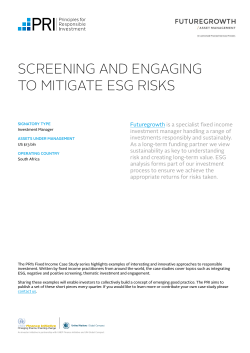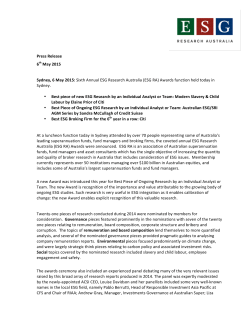
complying with your fiduciary duty: a global road map for esg
COMPLYING WITH YOUR FIDUCIARY DUTY: A GLOBAL ROAD MAP FOR ESG INTEGRATION Edinburgh, 22 April 2015 On 22 April 2015, UNEP FI and PRI convened a panel discussion at the UKSIF 2015 Edinburgh Conference to explore how prevailing definitions and interpretations of fiduciary duty affect UK investors’ approach to the integration of environmental, social and governance (ESG) issues into their investment processes. The speakers were Dr Rory Sullivan (Senior Strategic Advisor, PRI), Professor Iain MacNeil (Alexander Stone Chair of Commercial Law, University of Glasgow), Marianne Harper Gow (Head of Governance, Baillie Gifford) and Fergus Moffatt (Head of Policy, UKSIF). The themes that emerged from the discussion included: ■ There has been extensive discussion of fiduciary duty in the UK. Of particular importance are the Kay Review of UK equity markets and long-term decision making (2012), and the Law Commission report on the fiduciary duties of investment intermediaries” (2014) and the Department of Work and Pensions’ 2015 consultation on changes to the law on investments in ■ occupational pension schemes.. Fiduciary duty should not be seen as a barrier to ESG integration. There is broad consensus that issues such as climate change should be taken into account in investment decisions to the ■ extent that these issues are relevant to the investment decision being made. The UK Stewardship Code has been hugely important in signalling that asset owners and investment managers should engage with the companies in which they are invested. To date, however, relatively little attention has been paid to the manner in which the Code is being implemented by signatories and there is a need for more robust monitoring and scrutiny of implementation., Debates about fiduciary duty have often mixed up (or conflated) the duties owed by different actors in the investment chain. Of particular importance is recognising that the trustees of asset owners have portfolio-wide responsibilities whereas company directors and boards have responsibility to the company. These differences may mean that the interests of ■ trustees and of company management are not always aligned. There is a question about how different timeframes – e.g. of the different beneficiaries of a fund, of the fund as a whole, of company management, of wider society (e,g. future generations) – can be reconciled. ■ While an increasing number of asset owners have made commitments to responsible investment and long-term investment, the implementation of these commitment remains weak. Some investment managers commented that while they are under pressure to incorporate long term ■ horizons, but they are still judged on a quarterly basis performance review. There are ongoing capacity needs in the investment industry. For example, asset owners need to develop their ability to scrutinise and hold investment managers to account for their approach to ESG integration. The panel discussion formed part of PRI and UNEP FI’s project on fiduciary duty and ESG integration. The project will examine the barriers to ESG integration in eight countries – Australia, Brazil, Canada, Germany, Japan, South Africa, UK, and USA – and will propose practical actions for institutional investors and policy-makers to address these barriers. For further information or to contribute to the project, please contact Will Martindale (Head of Policy, PRI) at will.martindale@unpri.org or Elodie Feller (Investment Commission Co-ordinator, UNEPFI) at elodie.feller@unep.org .
© Copyright 2025





















